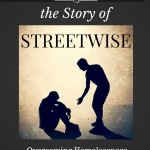 Coming Home:
Coming Home:
Children need to grow up in a safe environment
acrylic painting/ 16” by 19” / $ 195
Repatterning the Brain
While reading and interviewing those who work with homeless and runaway youth I kept asking myself if there is hope that we will get ahead of this crisis. The reported number of street kids keeps escalating and I am concerned. Over the past half year, though, I have become more positive in my outlook because I learned of therapies that do work. Some treatments have been developed because of our growing knowledge of how the brain works. I take this opportunity to share what I have learned about repatterining treatments for a better future. Those of you working in the field may want to add to my comments.
As a child we learned to crawl by coordinating our muscles to move – first the right arm, then left leg, left arm followed by right leg. This learned neurological process we developed on the floor was then carried forward to walking. Our practice formed on- off switches that helped co-ordinate the muscles we used in locomotion, posture and balance.
Nerves in our body are alive with energy and every time we do a new exercise or learn a new fact neurological connections are made. The more active we are the stronger the network of nerves develops to keeps us functioning well. Those who do little often lose their ability to move with ease, but those willing to become active soon get it back.
Cross crawl marching, is a therapy employed for people suffering from certain types of traumatic brain injury. The shock to their system that left them confused and uncoordinated caused their muscles to relax with resultant disability. Repatterining exercises are one form of therapy used to fix the problem. Repatterining has been found to be effective in minimizing dyslexia, ADD, handwriting and coordination problems and other learning disabilities.
In addition to the physical realm, trauma can also precipitate emotional disfunction. A newborn child is usually develops trust when surrounded by a nurturing, secure environment. But when trauma is introduced such as child abuse, hunger, loss of home or drugs the child’s brain is shocked. Their newly scrambled neurological connections can lead to a state of confusion.
Researchers can now identify the impact of stress through brain scans that record the result of long-term physical and psychological abuse. The limbic system, often called the ‘emotional brain’ controls emotions that drive survival. It is the center for fight, flight or freeze responses. It communicates with the more rational cortex which is slower to respond.
Most adjusted people rely on the cortex to navigate their way through life. When a child has experienced frequent abusive encounters, however, instead of staying calm to problem solve he or she may misinterpret the threat and respond inappropriately because of an overactive limbic system. Victimized children have nervous systems that are on constant alert because they anticipate further danger.
Just as with physical disabilities repatterning is used as a therapy. It may take many years to repattern a brain and nervous system even after the environment becomes safe. Repatterning is a natural healing remedy used to relieve trauma, abuse, stress, anxiety and fear. It is even used to aide concentration and memory and enhance sports performance. A variety of therapies come under the umbrella of repatterining, including such techniques as Eye Movement Desensitization to targeting stressful thoughts as a way of allowing natural energy to resume and bring relief.
It is good to know that there is hope for turning lives around. Relief is more readily available because of the good work being done by brain researchers.
______________
Art work is always for sale. Contact me at email.
I would love to hear from you. Please respond on my blog site.
 For sale on Amazon: The True Story of Streetwise, overcoming homelessness and beating the odds. Go to Streetwise.
For sale on Amazon: The True Story of Streetwise, overcoming homelessness and beating the odds. Go to Streetwise.
References:
http://www.headbacktohealth.com/Cross_crawl.html – reference about repatterning.
http://www.cdcrehab.com/brain-integration-therapy – repatterning the brain during therapy
http://www.asca.org.au/WHAT-WE-DO/Resources/General-Information/Impact-on-the-physiology-of-the-brain – From an Adults Surviving Child Abuse article.
http://www.brainbreakthrough.com/modalities.html – Therapies used to repattern.
Home » Blog » Repatterning the Brain
Table of Contents
Children need to grow up in a safe environment
acrylic painting/ 16” by 19” / $ 195
Repatterning the Brain
While reading and interviewing those who work with homeless and runaway youth I kept asking myself if there is hope that we will get ahead of this crisis. The reported number of street kids keeps escalating and I am concerned. Over the past half year, though, I have become more positive in my outlook because I learned of therapies that do work. Some treatments have been developed because of our growing knowledge of how the brain works. I take this opportunity to share what I have learned about repatterining treatments for a better future. Those of you working in the field may want to add to my comments.
As a child we learned to crawl by coordinating our muscles to move – first the right arm, then left leg, left arm followed by right leg. This learned neurological process we developed on the floor was then carried forward to walking. Our practice formed on- off switches that helped co-ordinate the muscles we used in locomotion, posture and balance.
Nerves in our body are alive with energy and every time we do a new exercise or learn a new fact neurological connections are made. The more active we are the stronger the network of nerves develops to keeps us functioning well. Those who do little often lose their ability to move with ease, but those willing to become active soon get it back.
Cross crawl marching, is a therapy employed for people suffering from certain types of traumatic brain injury. The shock to their system that left them confused and uncoordinated caused their muscles to relax with resultant disability. Repatterining exercises are one form of therapy used to fix the problem. Repatterining has been found to be effective in minimizing dyslexia, ADD, handwriting and coordination problems and other learning disabilities.
In addition to the physical realm, trauma can also precipitate emotional disfunction. A newborn child is usually develops trust when surrounded by a nurturing, secure environment. But when trauma is introduced such as child abuse, hunger, loss of home or drugs the child’s brain is shocked. Their newly scrambled neurological connections can lead to a state of confusion.
Researchers can now identify the impact of stress through brain scans that record the result of long-term physical and psychological abuse. The limbic system, often called the ‘emotional brain’ controls emotions that drive survival. It is the center for fight, flight or freeze responses. It communicates with the more rational cortex which is slower to respond.
Most adjusted people rely on the cortex to navigate their way through life. When a child has experienced frequent abusive encounters, however, instead of staying calm to problem solve he or she may misinterpret the threat and respond inappropriately because of an overactive limbic system. Victimized children have nervous systems that are on constant alert because they anticipate further danger.
Just as with physical disabilities repatterning is used as a therapy. It may take many years to repattern a brain and nervous system even after the environment becomes safe. Repatterning is a natural healing remedy used to relieve trauma, abuse, stress, anxiety and fear. It is even used to aide concentration and memory and enhance sports performance. A variety of therapies come under the umbrella of repatterining, including such techniques as Eye Movement Desensitization to targeting stressful thoughts as a way of allowing natural energy to resume and bring relief.
It is good to know that there is hope for turning lives around. Relief is more readily available because of the good work being done by brain researchers.
______________
Art work is always for sale. Contact me at email.
I would love to hear from you. Please respond on my blog site.
References:
http://www.headbacktohealth.com/Cross_crawl.html – reference about repatterning.
http://www.cdcrehab.com/brain-integration-therapy – repatterning the brain during therapy
http://www.asca.org.au/WHAT-WE-DO/Resources/General-Information/Impact-on-the-physiology-of-the-brain – From an Adults Surviving Child Abuse article.
http://www.brainbreakthrough.com/modalities.html – Therapies used to repattern.
Table of Contents